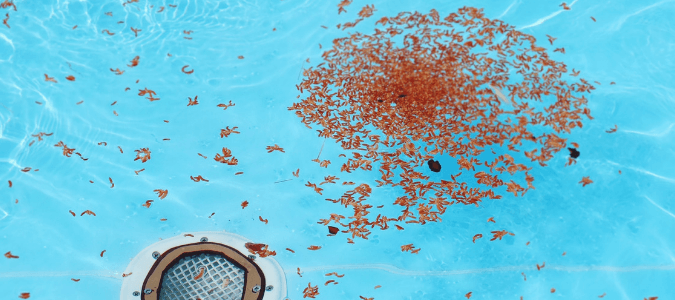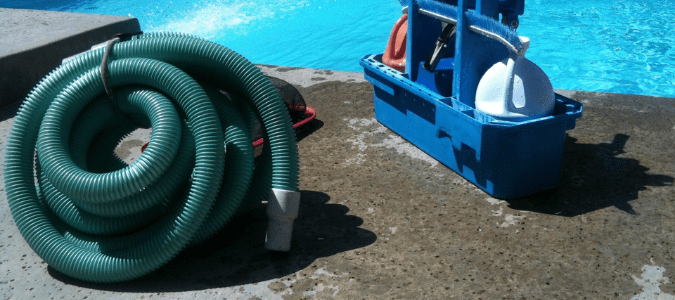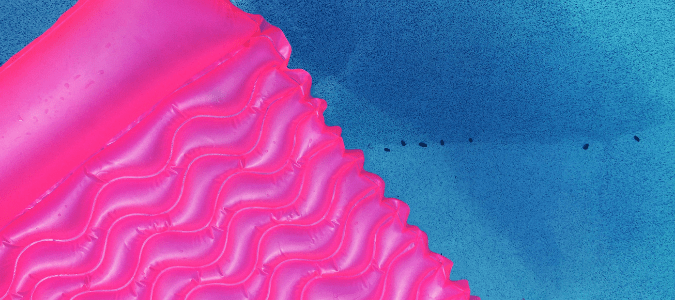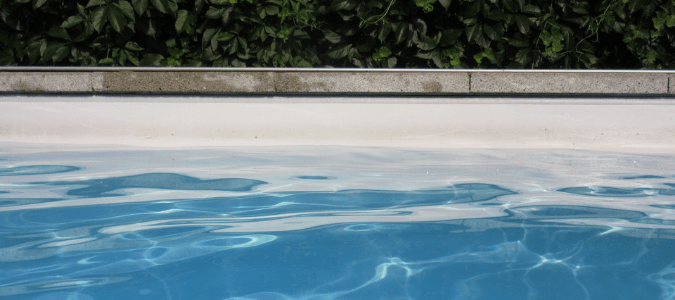
Most pool owners keep their chemicals balanced and use a hand skimmer when necessary to fish out leaves, twigs and other yard waste. But sometimes, big storms can bring all sorts of dirt and debris that can end up in a pool.
After one of these major weather events, or even after an infestation of algae, you may hope that your skimmer system can get your pool water clean again. But what if a few days go by, and it isn’t happening? Does this mean it’s time to manually vacuum your pool?
If you want to clean the bottom of your pool using your skimmer, you’ll need to gather the following materials:
- A vacuum head—otherwise known as a vac head.
- A telescopic pole that is long enough to reach even the deepest parts of your pool.
- A vacuum hose that also can reach every part of your swimming pool.
You may want to use a skimmer vacuum plate, sometimes also called skim vac. This allows you to use the skimmer basket. Without it, vacuuming will still work, but you’ll have to use the pump strainer basket.
Getting Set Up
Once you have assembled all the needed parts, you’ll need to do the following:
- Attach the vacuum head to the telescoping pole.
- Take and attach one end of the vacuum hose to the vacuum head’s outlet fitting.
- Submerge the vacuum head to the bottom of your pool’s deep end.
- Push the entire length of the vacuum hose under water until the hose fills with water.
The third and fourth steps are meant to purge air from your vacuuming components. If air pockets are allowed to get into the pump’s intake line, they can make the pump lose its prime.

Connecting The Pool Vacuum To The Skimmer Suction
Now, you’ll need to attach the vacuum head to your skimmer by:
- Locating the skimmer at the side of your pool.
- Removing the skimmer lid and strainer basket.
- Threading your hose carefully through the skimmer inlet while keeping the open end of the hose submerged at all times.
- Plugging the open end of the hose into the skimmer’s suction port, which lies at the bottom of the skimmer well.
Depending on how your pool is set up, you may need to alter the process slightly. Here are a few other things you should keep in mind:
- If your pool has more than one skimmer, you’ll want to plug the vacuum hose into the skimmer closest to the pool pump to give you the maximum vacuum force.
- If each skimmer in your pool has its own dedicated skimmer valve, be sure to close all other valves except the valve for the skimmer that you’ll be using to vacuum the pool.
Start vacuuming at your pool’s shallow end, using slow, long strokes. You’ll want to overlap your strokes slightly to make sure you are vacuuming up all the debris at the bottom of your pool. Rushing will usually just mean the job takes longer, since going too fast will kick up debris that will take some time to settle. If your pool is especially dirty, you may notice your water becoming cloudy, no matter how careful you are. If that’s the case, you’ll need to wait a few hours for the materials floating to land on the bottom and then vacuum again.
Once you are done, detach the vacuum head from your pole and drain water that has collected in your hose. Connect a cleaning brush to the pole and scrub off any materials which have collected along your pool walls. Finally, test your pool chemistry and make any adjustments, as necessary. Clean off your equipment with a hose and place them in storage to keep these parts working as long as possible. Once your pool is balanced, it’s time for some swimming!
If vacuuming a pool by hand sounds like a lot of work, it is. Many pool owners prefer to hire a pool cleaning company to keep their water clean and crystal clear. Now that you know how to vacuum a pool manually, let’s discuss in more detail your pool’s circulation system and how to troubleshoot problems.

How Does A Pool Skimmer Work? Types of Skimmers
As you probably already know if you have a pool, skimmers are a major part of your pool circulation system. These components are essentially the gateway to your pool’s filtration system. This is pretty much true no matter what kind of automatic skimmer system you have.
A skimmer uses suction to captures waste in your pool before it lands on the floor, whether you have dead bugs, dirt, flower petals, leaves, twigs or even oil from sunscreen in your water. The different types of skimmers are floating skimmer, robotic skimmers and in-wall skimmers.
Floating Skimmers
Some pools have floating skimmers attached to a pool vacuum. Such skimmers float around the pool, randomly collecting debris from the water surface. These types of skimmers are most common in above-ground pools.
Robotic Skimmers
The vast majority of swimming pools in America have stationary skimmers. Nevertheless, robotic pool skimmers have been developed in recent years as an alternative to these stationary models. Robotic skimmers are fully- or semi-automated and powered by batteries or solar energy. These skimmers float on the pool water and move around collecting dirt, debris and swimming pool bugs.
In-Wall Pool Skimmers
These types of skimmers resemble small rectangular buckets built into the side of the swimming pool walls where your pool meets the hardscape surrounding it. You can access the skimmer through a hatch or trap door located on the pool deck area. These components are typically made of PVC or precast concrete. Within the skimmer is a basket that holds leaves and other debris skimmed from the pool water. Skimmers also have a door over the front side called a weir.
The weir performs a skimming action that pulls in just the top, thin layer of water. The level and movement of water in the pool are the chief determinants of how the weir opens and closes. Additionally, the weir closes once the pump is turned off to prevent the debris collected in the skimmer basket from floating back into the pool.
Every skimmer must be fitted with an equalizer line. The equalizer line runs from the skimmer basket through the wall of the pool into the water. This part plays a critical role in preventing air from getting into the pool filtration system if the pool water level drops below the level of the skimmer weir. If air gets into the system, the pool pump may become damaged.
Something important to note is that skimmers don’t just collect yucky stuff from the surface of your swimming pool. By removing the larger debris, skimmers help the filter do a much better job of eliminating other, smaller contaminants, which enhances the overall cleanliness of your pool. Additionally, some skimmers are equipped with automatic chlorinators, which makes your pool more sanitary.
Because of all this, skimmers have an integral role in extending the longevity of your pool pump and filter.
What if you suspect your skimmer is losing its suction? Keep reading to learn how to address this and other circulation issues.

How To Adjust Pool Skimmer Suction
There are a few reasons that your vacuum might not be working properly. The usual culprits are having excess air in your system, if there is a blockage or if you have a leak. You’ll want to first empty your skimmer box basket to make sure you don’t have a build-up of debris and then put it back in. Then, check your pool pump basket for a blockage or debris.
When you replace the basket, make sure the hole is facing the in pipe. Make sure your O ring is in good condition when you reassemble the pool pump. Also, securely close the lid of your pump and look to see if there are any leaks coming into or out of the pump. Move from the pump to your filtration system, examining all the connections for any signs of deterioration or leakage. Look at the gate valve to make sure the setting is correct.
If everything looks good, perform a backwash, as that can sometimes help with low pressure. When that’s done, you should see about 75 psi for the suction to be working properly. If there is still a problem, you probably have a leak in your system, which is generally a more involved repair best performed by an experienced pool technician.

Pool Skimmer Not Working: What’s Happening?
The skimmer relies on the pool’s pump system to pull in water. The water is then drawn through the swimming pool’s entire circulation system. A skimmer that’s not working is usually a sign that there might be some other issues in your pool that require technical maintenance and possibly repair.
Nevertheless, a pool skimmer might fail to work as it should if:
- It’s clogged
- It requires backwashing
- The skimmer basket is too dirty
- There isn’t enough water in pool or there is too much water in pool after rainfall
Pool Circulation Problems, Skimmers And More
Maintaining crystal clear water requires several things on the part of a pool owner: the proper chemical balance, maintaining effective circulation in the pool and routine cleaning and maintenance.
Maintaining adequate circulation is a multitiered process that involves much more than simply ensuring that the skimmer weirs are open. It includes many other things, like identifying and cleaning dead spots, optimizing the angle and placement of returns, appropriately sizing the pool pump and effectively and expertly addressing a number of issues that might arise from the many different pool components.
ABC Can Keep Your Pool Clean And Ready For Swimming
If you wonder if something is amiss with your pool, your best bet is to work with a pool expert who can save you time and make any needed repairs, getting the job done right the first time. The skilled technicians at ABC Home & Commercial Services perform this type of work day in and day out. As a full-service provider, ABC can help with anything from regular cleanings to water testing to routine maintenance. With ABC’s help, you can spend your weekends swimmng, rather than working on your pool.
